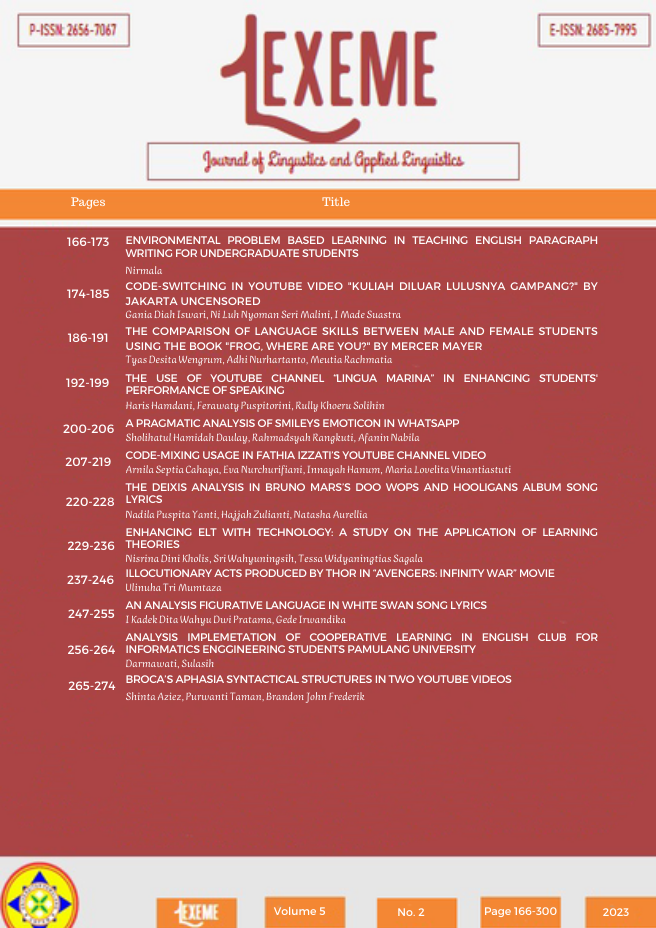EXPLORING THE CROSS CULTURE UNDERSTANDING IN INDONESIAN EFL CONTEXT: A LITERATURE REVIEW
DOI:
https://doi.org/10.32493/ljlal.v5i2.31731Keywords:
cross culture understanding, EFL, IndonesiaAbstract
The objective of the present study is to elaborate some cross-cultural understanding importance for Indonesian EFL students, and the role of EFL teaching in minimizing students’ misunderstanding while using English. This study uses literature review study for collecting the data coming from some sources in the forms of books, and journal articles regarding Cross Culture Understanding in Indonesia. In analyzing the data, the qualitative data from the sources were read, analyzed, classified, and concluded. Based on the result of the study, it is important to teach and provide more cultural content for strengthening the cross culture understanding of the Indonesian students while they are learning English. This study also finds that cross culture understanding materials may give beneficial impact that support the improvement of their English language skills. Moreover, the role of integrating cross cultural understanding content in EFL practice in minimizing the misunderstanding in using English has been proven positively. To sum up, cross-culture understanding in English language teaching in Indonesia should be considered as an important element to be involved in English teaching and learning activity to achieve learning outcomes, and to create Indonesia’s generation to be ready to compete in the era of global competition.
References
Al-Obaydi, L. H. (2019). Cultural diversity, awareness and teaching: A study in an EFL context. Journal of Asia TEFL, 16(3), 987–995. https://doi.org/10.18823/asiatefl.2019.16.3.15.987
Dixon, L. Q., Zhao, J., Shin, J. Y., Wu, S., Su, J. H., Burgess-Brigham, R., Gezer, M. U., & Snow, C. (2012). What we know about second language acquisition: A synthesis from four perspectives. Review of Educational Research, 82(1), 5–60. https://doi.org/10.3102/0034654311433587
Efriza, D., Syarif, H., & Zainil, Y. (2022). The Implementation of EFL Curriculum in Indonesia: A Literature Review. Proceeding of the 2nd International Conference on Language Pedagogy, 97–105.
English First. (2019). Indeks Kecakapan Bahasa Inggris EF. 52.
Erwin Prasetyo, D. (2021). Embedding the Local Sociocultural in Indonesia for English Writing Skill. Jurnal Pendidikan Bahasa Dan Sastra, 21(2), 157–170. https://doi.org/10.17509/bs_jpbsp.v21i2.44627
Gandana, I., & Parr, G. (2013). Professional identity, curriculum and teaching Intercultural Communication: An Indonesian case study. Language, Culture and Curriculum, 26(3), 229–246. https://doi.org/10.1080/07908318.2013.833620
Hartono, R. (2017). Culture-related Content in an EFL Textbook: A Need for Locally Relevant Materials. Lingua, Jurnal Bahasa & Sastra , 18(1).
Hibatullah, O. F. (2019). The Challenges of International EFL Students to Learn English in a Non-English Speaking Country. Journal of Foreign Languange Teaching and Learning, 4(2). https://doi.org/10.18196/ftl.4240
Larsen-freeman, D., & Anderson, M. (2011). Technique & Principle in Language Teaching (Third Edition). Oxford University Press.
Mahadi, T. S. T., & Jafari, S. M. (2012). Language and Culture. International Journal of Humanities and Social Science, 2(17). www.ijhssnet.com
Mahaputri, R. A., Dewi, F. R., & Purnawarman, P. (2021). Evaluating EFL Students’ Attitudes Towards Cultural Differences: Conversation analysis of Intercultural Communication. Proceedings of the Thirteenth Conference on Applied Linguistics (CONAPLIN 2020), 546.
Maili, S. N., & Hestiningsih, W. (2017). Masalah-Masalah Pembelajaran Bahasa Inggris Pada Sekolah Dasar. Media Penelitian Pendidikan : Jurnal Penelitian Dalam Bidang Pendidikan Dan Pengajaran, 11(1), 54–62. https://doi.org/10.26877/mpp.v11i1.2607
Morganna, R., Sumardi, S., & Tarjana, S. S. (2018a). Teaching Culture: The Prevailing Stance of Indonesian EFL Teachers. International Journal of Multicultural and Multireligious Understanding, 5(4), 317. https://doi.org/10.18415/ijmmu.v5i4.169
Morganna, R., Sumardi, S., & Tarjana, S. S. (2018b). Teaching Culture: The Prevailing Stance of Indonesian EFL Teachers. International Journal of Multicultural and Multireligious Understanding, 5(4), 317. https://doi.org/10.18415/ijmmu.v5i4.169
Mukundan, J. (2005). English Language Teaching Materials and Cross-Cultural Understanding : Are There Bridges. TEFLIN Journal, Volume XVI(1 Fbruari 2005), 42–53.
Pujiyanti, U., & Zuliani, F. R. (2014). CROSS CULTURAL UNDERSTANDING: A HANDBOOK TO UNDERSTAND OTHERS’ CULTURES. CV. Hidayah.
Rachmawati, I. (2018). DASAR-DASAR TEORI CROSS CULTURAL UNDERSTANDING. STKIP PGRI BANGKALAN. www.press.stkippgri-bkl.ac.id
Ramayana, V., Nurzannah, H. E., Batubara, M. H., & Lbs, M. (2022). Cross-Cultural Understanding in Learning English at IAIN Takengon Students. Journal of Linguistics, Literature and Language Teaching (JLLLT), 2(1), 1–5. https://doi.org/10.1017/CBO9780511486999
Rohmah, I. I. T. (2021). Cross Cultural Understanding (The Road To Travel The World). Perkumpulan Rumah Cemerlang Indonesia. www.rcipress.rcipublisher.org
Seniarika. (2017). Cross Cultural Perspective towards the Realization of EFL Learners’ Request Appropriateness and Politeness. English Education: Jurnal Tadris Bahasa Inggris, 10(1), 164–178. https://ejournal.radenintan.ac.id/index.php/ENGEDU
Sidabutar, U. (2020). CROSS CULTURE UNDERSTANDING. Universitas HKBP Nomensen.
Siti Marwah, U., & Astuti, I. W. (2022). The Representation of Local Culture in Indonesian Junior High School English Textbook; When English Rings a Bell Grade VIII. ELTICS (ENGLISH LANGUAGE TEACHING AND ENGLISH LINGUISTICS) JOURNAL, 7(1).
Snyder, H. (2019). Literature review as a research methodology: An overview and guidelines. Journal of Business Research, 104, 333–339. https://doi.org/10.1016/j.jbusres.2019.07.039







